Our tandem and trailer
My wife, Hilary, and I have been riding a Jack Taylor tandem for the past 5 years. We got it off of Craigslist because it sort of fit us and it was a fun novelty. It turns out that we actually work really well together on a tandem so that got me thinking about building a custom one that actually fit us. This tandem and trailer is the culmination of 5 years of riding research on geometry, load carrying, handling, component analysis, and general comfort. The result is this fillet brazed Turf Green tandem in front of you. The trailer is a nice add-on for grocery shopping or an extended tour. The front low rider racks are great for carrying some overnight gear for credit card touring when we don’t need the trailer.
The tandem frame is made from True Temper OX Platinum super oversize tubing. There are no laterals because of the large diameters of the tubing and our low combined weight. The fork blades are Reynolds tandem fork blades with the Pacenti MTB crown and heavy duty 1 1/8″ steerer. There are braze-ons for STI/bar end shifters as well as one down tube shifter boss to operate the Phil Wood drag brake. The rear hub was custom made by Phil Wood as their disc brake hasn’t been made since 1979.
The rear cantilever brake cable is routed internally for ease of portage. The cantilevers were fillet brazed from .035″ wall chromoly and designed to have a constant mechanical advantage over a large range of yoke heights. The stems are both custom fillet brazed as well. The stoker stem is adjustable with a keyway to prevent handlebar rotation. The stoker’s Brooks saddle has springs that, when combined with the 42mm 650b tires, provide a comfy ride (I’m told).
The bike is fully wired with front and rear lights power off of the Schmidt dynamo hub. There is also a Velo Lumino tail light on the trailer fender that plugs into a wire coming from the non-drive side chain stay. All the lights are operated by the Velo Lumino TMAT switch that is integrated into the stem cap.

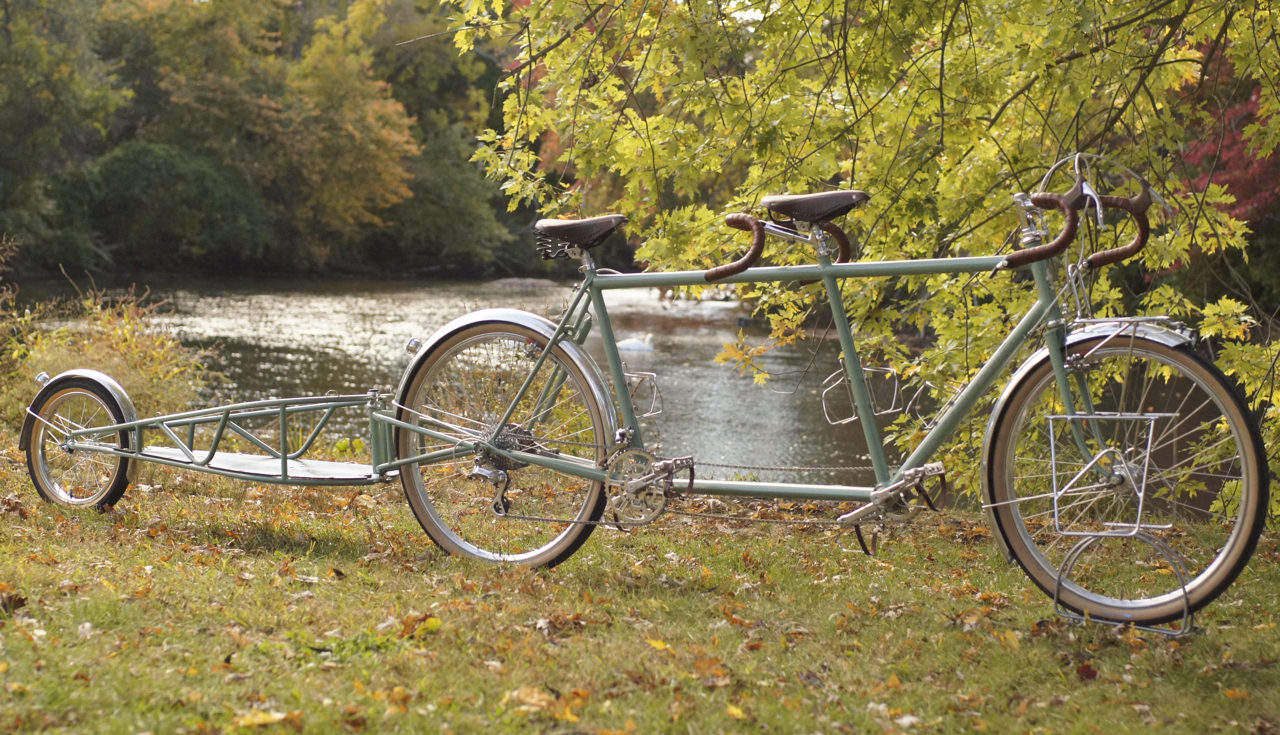
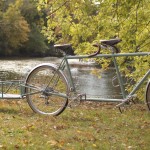
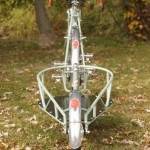
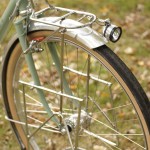
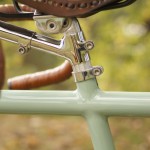
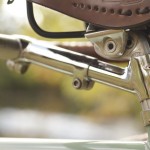
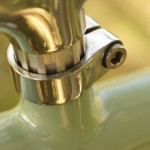
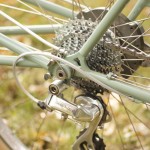
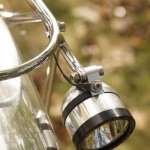
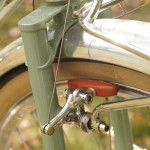
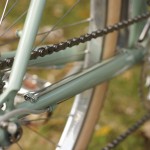
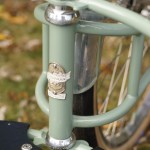
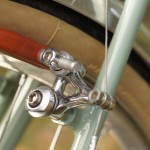
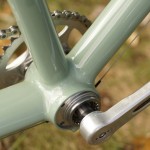
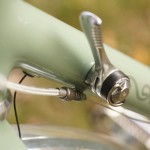
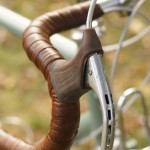
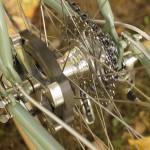
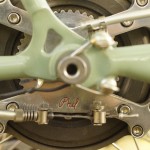
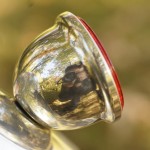
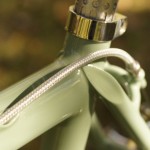
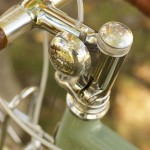
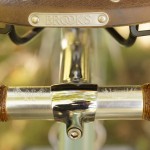
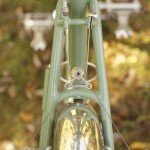
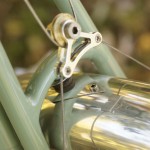
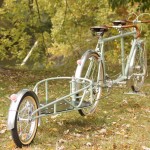






Jimmy Melnarik
November 26, 2024 @ 2:45 am
Still drooling over this all these years later
Steven Krusemark
November 20, 2015 @ 9:07 am
I have a Bill Boston Tandem that we had built for us in 1986 that had both front and rear Phil Wood brakes as the primary brakes. Both brakes were actuated by the one right brake lever. We then also had a Scott front rim brake actuated by the left lever. We toured the world and covered 22,000 miles for the next three years ending the trip in November of 1989. The Phil brakes worked well and had more than enough stopping power and would hold up on long descents without fading, and this with over 100 pounds of luggage at times while traveling in remote parts of Asia. We did have major problems with the brakes starting at about 15,000 miles. The surfaces of the drum housing and the surface of the push plate wore so there were ringed ridges on each surface. This then started causing the asbestos discs to wear out very quickly. Coming down the pass on the east side of Yosemite we almost went over the edge after the two newly installed discs wore in just one descent. We did send the brakes back to Phil Wood one at a time and he personally arranged to have the brakes completely refurbished and then they worked great. I am now completely refurbishing the tandem for the next world tour and will be installing rim cantilever brakes and will use a drag brake in the back. I am not sure if I will use the Phil brake, an Arai brake I already have, or a new Maddox brake. I am curious about how you convinced the Phil Wood company to make a new custom hub to work with the older Phil brake. I was under the impression that they will no longer support the old Phil brake with either parts, service and completely discourage their use. I would prefer to use the Phil brakes, but we want to change the hubs from a freewheel Phil hub to a new more modern cassette hub. I would look forward to also hearing how well the Phil brake has worked for you as a drag brake. We never did have a disc fail and had the latest version with the added material thickness against the hub splines.
All-in-all, you have beautiful bike. I also like the trailer design and would be interested in more information regarding the design and builder. We plan on using a trailer on our tour, but would prefer a two wheel trailer. We definitely travel with many com
Thanks,
Steven
Newburyport, Mass, USA
Brian
November 23, 2015 @ 11:30 am
Hi Steven,
Phil Wood didn’t really need convincing, I just asked politely! They let me know that the brake has not been a supported piece of equipment for some time now. So far, based on the few miles we have put on the tandem, the cantilevers have been doing great work on the down hills. The Phil brake has been fine on longer descents but we haven’t hit Yosemite yet. 🙂 Please email if you have any more questions.
Take care,
Brian
Willem
November 9, 2015 @ 3:20 pm
I had the privilege to see this tandem at the Philly Bike Expo, and it was really beautiful. Such perfection is rare. Congratulations.
John B.
November 3, 2015 @ 10:51 am
I was able to admire this beautiful machine in the metal at The Builders’ Ball. The craftsmanship and attention to detail are outstanding!
That said, I was surprised to see it featured a Phil Wood disk brake. They were renowned for failing spectacularly back in the day, rendering the brake inoperable. That and they utilise asbestos.
Regardless, I wish you many happy miles together.
Brian
November 3, 2015 @ 1:37 pm
John, don’t be surprised about the brake! It’s only being used as a drag brake on downhills. I still have two other brakes. The Phil Wood brake fail is when the teeth shear off the asbestos disc where it mates to the hub. I’ve only seen one documented case and it was used as the primary brake. If this was my only brake, then I’d be nervous. As for the asbestos, It’s pretty far out of the way on the back of the bike so breathing in asbestos would be a challenge!